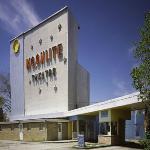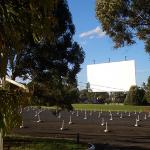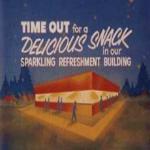June 02, 2011

Photo: Carol M. Highsmith
The Moonlite Theatre in Woodbury, Tennessee, is still very much in business.
This coming Monday marks a nostalgic anniversary in American culture. On June 6, 1933, the world's first drive-in movie theater opened in Camden, New Jersey.
By 1950, there were 4,000 of these "movies under the stars" across the country. Almost 80 years later, only a couple hundred survive.
At the drive-in - or what some of us called "the drive-in picture show" to distinguish it from drive-in restaurants - instead of wedging yourself into a theater seat next to talkative strangers, crying babies and large people blocking your view, you watched a movie on a huge screen from the comfort of your car, side by side with dozens of other autos in a sprawling parking lot.

J Bar, Wikipedia Commons
This drive-in theater is in Australia, but the photo gives you a good idea of how the speakers are lined up and waiting for cars and their occupants to arrive for the show.
You could bring your cranky baby along without disrupting anyone. Teenagers adored the romantic privacy of a dark automobile, to the point that some media referred to drive-ins as "passion pits."
The movies themselves mostly ranged from family fare to second-rate monster, science-fiction, and action thrillers. The sound that squawked out of the little speaker that you attached to your car window was tinny at best.
But the concession stand at the "Starlite" or "Hi-Way" or "Sunset" Drive-In did offer a full and fattening menu of fried food, popcorn and sodas. A lot of people smuggled in stronger drinks as well, and it wasn't unheard of to sneak in a person or two in the trunk, to avoid paying for more tickets.

Wikipedia Commons
Sometimes, along with a string of movie previews or cartoons before the main feature at the drive-in, you'd see an elaborate presentation about the many food options at the theater's concession stand.
The spread of daylight saving time cut into drive-in attendance, since dusk came late on balmy summer nights and the movie couldn't start until 9 p.m. or later. The advent of color television and video rentals kept people home as well.
When some drive-in owners sought to boost revenue by showing risqué movies, neighbors, parents and police drove them out of business. Other owners sold out to housing and shopping-center developers.
Many U.S. cities have tried to recapture the nostalgic feeling of outdoor movies by showing films in parks and pedestrian malls. But patrons sit on blankets, not in their '54 Chevys.
And no one's writing tunes like the Beach Boys' "Drive-In" song, which goes, in part:
Every time I have a date there's only one place to go
That's to the drive in
It's such a groovy place to talk and maybe watch a show